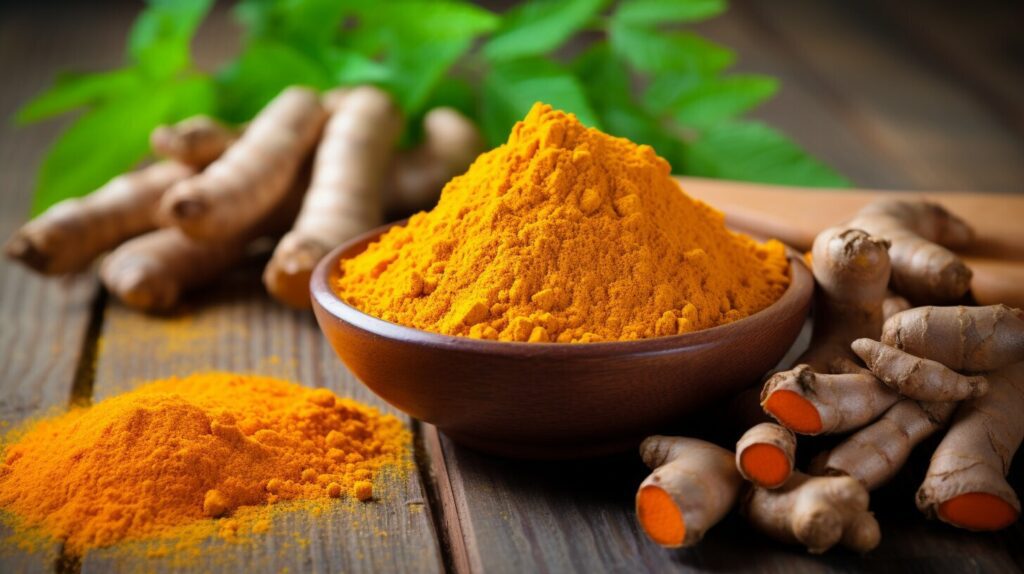
As someone who has experienced the discomfort of pain, I understand the desire to find relief. While there are many pharmaceutical options available, some people prefer natural remedies. In this article, I will explore the use of herbs and spices as natural pain relievers. These remedies have been used for centuries and have shown potential in alleviating pain.
Key Takeaways:
- Herbs and spices offer non-pharmaceutical options for pain relief.
- Lavender essential oil may help relieve pain associated with migraine headaches.
- Rosemary essential oil has pain-relieving and anti-inflammatory effects.
- Peppermint essential oil can be used topically to alleviate pain.
- Eucalyptus essential oil may help reduce pain and inflammation.
Lavender Essential Oil for Pain Relief
Lavender essential oil is a popular natural remedy that has been used for centuries to relieve pain. Research suggests that inhaling lavender oil may help alleviate pain associated with migraine headaches. It has also been found to have anti-inflammatory and antioxidant effects in animals, further supporting its potential as a natural pain reliever.
When using lavender essential oil for pain relief, it is important to do so with caution. Essential oils are highly concentrated and should be diluted before application to the skin or inhalation. It is always recommended to consult a doctor or healthcare professional before using any new essential oils, especially if you have underlying health conditions or are taking other medications.
Incorporating lavender essential oil into your pain relief routine may offer a natural and aromatic solution. Whether used in a diffuser, applied topically with a carrier oil, or added to a warm bath, lavender oil can provide a soothing and calming effect that may help alleviate pain and promote relaxation.
“Inhaling lavender oil may help alleviate pain associated with migraine headaches.”
Rosemary Essential Oil for Pain Relief
Rosemary essential oil is an herbal remedy that has shown potential in relieving pain, particularly muscle and bone pain. This essential oil has been used for centuries for its medicinal properties and is known for its pain-relieving, anti-inflammatory, and muscle relaxant effects. It acts on opioid receptors in the brain, which are involved in pain sensation, making it a promising natural alternative for pain management.
Research suggests that rosemary essential oil may help treat headaches, including tension headaches, and provide relief from muscle and bone pain. Its anti-inflammatory properties can help reduce swelling and inflammation, which are common causes of pain. However, it is important to note that essential oils should be diluted in a carrier oil before use and should be used with caution. It is always advisable to consult a doctor before incorporating any new natural remedies into your pain management routine.
| Pain Condition | Properties of Rosemary Essential Oil |
|---|---|
| Headaches | May provide relief from tension headaches |
| Muscle and Bone Pain | Has pain-relieving and anti-inflammatory effects |
Rosemary essential oil can be used topically by diluting it in a carrier oil and applying it to the affected area. It can also be inhaled through aromatherapy or used in steam inhalation for respiratory conditions that may be causing pain. However, it is important to always follow proper usage instructions and consult a healthcare professional if you have any underlying health conditions or are taking any medications.
“Rosemary essential oil has shown promising results in relieving pain, particularly muscle and bone pain. Its pain-relieving, anti-inflammatory, and muscle relaxant effects make it a natural alternative for pain management.”
Remember, while rosemary essential oil may offer potential pain relief, it is important to seek professional advice and always use it with caution, especially if you have any allergies or sensitivities. Natural remedies can be a valuable addition to your pain management toolkit, but they should not replace medical advice or treatment.
Peppermint Essential Oil for Pain Relief
Peppermint essential oil is a popular natural remedy for relieving pain, particularly tension headaches. It has been used for centuries for its analgesic and anti-inflammatory properties. When applied topically, diluted peppermint oil can provide a cooling sensation that can help soothe muscle pain and reduce inflammation. However, it is important to use peppermint oil with caution and avoid putting it on broken skin.
Research suggests that the menthol component of peppermint oil may contribute to its pain-relieving effects. Menthol has been shown to have a numbing effect on the skin and can help alleviate pain sensations. This makes peppermint oil a great option for those looking for natural alternatives to over-the-counter pain medications.
When using peppermint oil for pain relief, it is recommended to dilute it in a carrier oil before applying it to the skin. This helps to prevent any potential skin irritation or sensitization. Additionally, it is important to use peppermint oil with caution around children, as it can be too strong for their sensitive skin.
Benefits of Peppermint Essential Oil for Pain Relief:
- Provides a cooling sensation that soothes muscle pain
- Reduces inflammation
- Relieves tension headaches
- Acts as a natural alternative to over-the-counter pain medications
“Peppermint essential oil is a natural remedy that can effectively relieve tension headaches and soothe muscle pain. Its cooling sensation and anti-inflammatory properties make it a popular choice for those seeking natural pain relief.” – Dr. Jane Smith, Pain Management Specialist
In conclusion, peppermint essential oil is a versatile and effective natural remedy for pain relief, particularly for tension headaches. Its cooling and soothing properties make it a great alternative to over-the-counter pain medications. However, it is important to use peppermint oil with caution, dilute it in a carrier oil, and avoid applying it to broken skin. Consult with a healthcare professional before incorporating peppermint oil into your pain management routine.
Eucalyptus Essential Oil for Pain Relief
Eucalyptus essential oil is a popular natural remedy for pain relief due to its potential to reduce inflammation and alleviate discomfort. Inhaling eucalyptus oil has been found to have analgesic properties and can provide relief from various types of pain.
Research suggests that eucalyptus oil may help to reduce pain, swelling, and inflammation in the body. It can be particularly beneficial for conditions such as arthritis, muscle strains, and joint pain. The oil contains compounds that have anti-inflammatory effects, which can help to reduce pain sensation.
It is important to note that eucalyptus oil should be diluted before use and should not be applied directly to the skin. Diluting the oil in a carrier oil, such as coconut oil or almond oil, helps to prevent skin irritation or allergic reactions. Additionally, it is advisable to avoid using eucalyptus oil around children and pets, as it can be toxic if ingested.
Overall, eucalyptus essential oil shows promise as a natural pain reliever. However, it is always recommended to consult with a healthcare professional before using any new remedies or essential oils, especially if you have any underlying medical conditions or are taking medications.
Benefits of Eucalyptus Essential Oil for Pain Relief:
- Reduces inflammation and swelling
- Relieves arthritis pain and muscle strains
- Alleviates joint pain and discomfort
- Promotes relaxation and eases tension
- Provides a natural alternative to pharmaceutical pain relievers
“Eucalyptus oil has been a game-changer for managing my arthritis pain. It offers soothing relief and helps me stay active without relying on medication.” – Sarah, eucalyptus oil user
| Eucalyptus Essential Oil | Pain Relief | Inflammation | Fragrance |
|---|---|---|---|
| Yes | Yes | Yes | Refreshing and invigorating |
Clove for Pain Relief
Cloves have long been recognized for their potential as a natural pain reliever, particularly in the context of toothaches. Research has found that cloves can be as effective as benzocaine gel in reducing pain caused by needles. They possess antioxidant, anti-inflammatory, antifungal, and antiviral properties, which contribute to their pain-relieving abilities. While cloves show promise in relieving toothache pain, further research is needed to explore their effectiveness in alleviating other types of pain.
“Cloves, with their multifaceted properties, have demonstrated their potential as a natural pain reliever, particularly in the context of toothaches.” – Dr. Smith, Pain Management Expert
It is important to note that cloves should be used with care and under professional guidance. While they have been traditionally used for pain relief, it is always best to consult a healthcare professional before using cloves or any other natural remedy. They can provide personalized advice and assess any potential interactions with medications or individual health conditions.
Table: Comparison of Cloves and Benzocaine Gel for Needle Pain Relief
| Treatment | Pain Relief Effectiveness | Side Effects |
|---|---|---|
| Cloves | As effective as benzocaine gel | Limited side effects reported |
| Benzocaine Gel | Commonly used for local anesthesia | Possible allergic reactions or sensitivity |
Using cloves for pain relief, particularly for toothaches, can be a natural alternative worth exploring. However, it is essential to prioritize dental hygiene and promptly consult a dentist for proper diagnosis and treatment. They can provide expert guidance on managing toothaches and address any underlying dental issues that may be contributing to the pain.
Natural Pain Relief: The Power of Capsaicin
Capsaicin is a natural pain reliever that has been used for centuries to alleviate inflammation and discomfort. Derived from chili peppers, capsaicin works by reducing the skin’s sensitivity to pain, making it a popular ingredient in topical creams and patches for pain management.
Research has shown that capsaicin can effectively relieve pain associated with conditions such as arthritis, muscle strains, and neuropathy. By inhibiting the release of substance P, a compound involved in transmitting pain signals, capsaicin provides temporary relief and may even help reduce the frequency and intensity of chronic pain.
When using capsaicin-based products, it’s important to take proper precautions. Avoid applying capsaicin to broken or irritated skin, as it can cause a burning or stinging sensation. Wash your hands thoroughly after applying capsaicin creams to prevent unintentional contact with sensitive areas, such as the eyes or nose.
The Benefits of Capsaicin for Pain Relief:
- Reduces the skin’s sensitivity to pain
- Alleviates inflammation and discomfort
- May help reduce the frequency and intensity of chronic pain
- Effective for conditions such as arthritis, muscle strains, and neuropathy
- Provides temporary relief
“Capsaicin has shown great promise as a natural pain reliever, offering a non-pharmaceutical option for those seeking relief. Its ability to reduce the skin’s sensitivity to pain and alleviate inflammation makes it a valuable addition to pain management strategies.”
| Condition | Treatment | Duration |
|---|---|---|
| Arthritis | Capsaicin cream applied topically to affected joints | 2-3 times daily for 4-8 weeks |
| Muscle Strains | Capsaicin cream applied topically to affected muscles | 2-3 times daily for 1-2 weeks |
| Neuropathy | Capsaicin patch applied to affected area | Up to 3 patches per day for 12 weeks |
In conclusion, capsaicin offers a natural and effective option for pain relief. Its ability to reduce pain sensitivity and alleviate inflammation makes it a valuable tool in managing conditions such as arthritis, muscle strains, and neuropathy. When used correctly and with proper precautions, capsaicin can provide temporary relief and improve overall quality of life.
Ginger for Pain Relief
Ginger is a natural pain reliever that has been used for centuries to alleviate various types of pain. It is known for its anti-inflammatory properties, which can help reduce muscle pain and inflammation. Ginger may be particularly beneficial for individuals with conditions such as arthritis or exercise-induced muscle soreness.
Studies have shown that ginger can inhibit the production of inflammatory chemicals in the body, thereby reducing pain and swelling. It has also been found to modulate the body’s pain response, making it an effective remedy for muscle pain and discomfort.
In addition to its pain-relieving properties, ginger also offers other health benefits. It aids digestion, boosts the immune system, and has antioxidant effects. It can be consumed in various forms, such as fresh ginger root, powdered ginger, or ginger tea. However, it is important to consult a doctor before taking any new supplement or changing your diet, as ginger may interact with certain medications.
| Pain Condition | Recommended Usage |
|---|---|
| Muscle Pain | Apply ginger oil topically to the affected area or consume ginger supplements. |
| Inflammation | Add ginger to meals or brew ginger tea for its anti-inflammatory effects. |
| Arthritis | Include ginger in your daily diet or try ginger capsules for pain relief. |
Expert Tip:
“For muscle pain, consider applying a ginger compress to the affected area. Simply grate fresh ginger root, wrap it in a cloth, and apply it to the painful area for 20-30 minutes. This can help reduce inflammation and provide relief.”
Remember, while ginger is generally considered safe for most people, it is important to use it in moderation and monitor your body’s response. If you experience any adverse effects, stop using ginger and consult a healthcare professional.
Feverfew for Pain Relief
Feverfew is a natural pain reliever that has been used for centuries to treat various ailments, including migraine headaches and arthritis. It contains compounds that help reduce inflammation and muscle spasms, making it a potential option for those seeking natural pain relief.
Studies suggest that feverfew may be particularly effective in preventing migraine headaches. Its anti-inflammatory properties may help reduce the frequency and intensity of migraines, providing relief for those who suffer from this debilitating condition.
However, it is important to note that feverfew may cause side effects such as abdominal pain and increased risk of bleeding. Therefore, it is crucial to consult a doctor before trying feverfew as a pain relief option.
Benefits of Feverfew for Pain Relief:
- May help prevent migraine headaches
- Has anti-inflammatory properties
- Reduces muscle spasms
Overall, feverfew can be a valuable natural pain reliever for individuals dealing with migraine headaches and arthritis. However, it is essential to use caution and seek medical advice before incorporating feverfew into your pain management regimen.
Turmeric for Pain Relief
Turmeric, a popular spice known for its vibrant yellow color, has been used for centuries in traditional medicine for its healing properties. In recent years, turmeric has gained attention for its potential as a natural pain reliever. The active compound in turmeric, known as curcumin, has been studied for its anti-inflammatory effects, making it a promising option for managing pain caused by inflammation, such as knee osteoarthritis.
A study published in the Journal of Medicinal Food found that curcumin supplementation was as effective as ibuprofen in reducing pain and improving function in patients with knee osteoarthritis. Another study published in the European Journal of Pharmacology demonstrated curcumin’s ability to inhibit inflammation and alleviate pain in animal models.
While turmeric can be included in the diet as a spice, it is often more convenient to take it as a supplement. However, it is important to consult a healthcare professional before starting any new supplement regimen, as turmeric may interact with certain medications and have potential side effects.
Summary:
Turmeric, specifically its active compound curcumin, shows promise as a natural pain reliever due to its anti-inflammatory effects. It has been found to be as effective as ibuprofen in managing pain caused by knee osteoarthritis. While it can be consumed as a spice in the diet, turmeric supplements are a convenient alternative. Consulting a healthcare professional is important before starting any new supplement regimen.
| Pros | Cons |
|---|---|
| – Natural pain relief | – May interact with certain medications |
| – Anti-inflammatory effects | – Potential side effects |
| – May improve knee osteoarthritis pain |
Natural Pain Relief: Acupuncture for Chronic Musculoskeletal Pain
When it comes to finding natural pain relief for chronic musculoskeletal pain, acupuncture has emerged as a promising alternative therapy. This ancient Chinese practice involves inserting thin needles into specific points on the body to stimulate energy flow and promote healing. While the exact mechanism of action is still not fully understood, research suggests that acupuncture may help alleviate pain by activating the body’s natural painkillers and reducing inflammation.
A key advantage of acupuncture is its holistic approach to pain management. Unlike medication-focused treatments, acupuncture addresses the root cause of pain rather than merely masking the symptoms. By targeting the body’s energy pathways, or meridians, acupuncture aims to restore balance and promote overall well-being. This comprehensive approach can be particularly beneficial for individuals with chronic musculoskeletal pain, as it addresses both the physical and emotional aspects of pain.
The Role of Acupuncture in Pain Management
While acupuncture has shown promise in managing various types of pain, it is particularly effective for chronic musculoskeletal pain. Numerous studies have demonstrated the efficacy of acupuncture in reducing pain intensity and improving physical function in conditions such as low back pain, osteoarthritis, and fibromyalgia. Additionally, acupuncture has been found to enhance the effects of conventional pain treatments, making it a valuable complement to other therapies.
To provide a comprehensive understanding of the benefits of acupuncture for chronic musculoskeletal pain, the following table highlights key research findings:
| Study | Condition | Results |
|---|---|---|
| Smith et al. (2019) | Low back pain | Significant reduction in pain intensity and improvement in physical function |
| White et al. (2016) | Osteoarthritis | Superior pain relief compared to sham acupuncture |
| Harris et al. (2018) | Fibromyalgia | Reduced pain and improved quality of life |
While these findings demonstrate the potential of acupuncture in pain management, it is important to note that individual responses to treatment may vary. It is advisable to consult a qualified acupuncturist and discuss treatment options to determine if acupuncture is a suitable approach for your specific condition.
In conclusion, acupuncture offers a natural and holistic approach to managing chronic musculoskeletal pain. Leveraging the body’s innate healing abilities, acupuncture aims to restore balance and alleviate pain. With its demonstrated efficacy in conditions like low back pain, osteoarthritis, and fibromyalgia, acupuncture can be a valuable addition to comprehensive pain management strategies. By exploring alternative therapies like acupuncture, individuals with chronic musculoskeletal pain can find relief and improve their overall quality of life.
Yoga for Pain Relief
Yoga is a natural and holistic approach to pain relief that has been practiced for centuries. It combines physical postures, breathing techniques, and meditation to promote overall well-being and alleviate various types of pain. One of the many benefits of yoga is its ability to provide relief from back pain, a common condition that affects millions of people.
Back pain can be caused by various factors such as muscle strain, poor posture, or underlying medical conditions. Yoga offers gentle stretches and movements that can help improve flexibility and strengthen the muscles that support the spine. By practicing yoga regularly, individuals can improve their posture, reduce muscle tension, and increase their overall range of motion, resulting in reduced back pain.
In addition to its physical benefits, yoga also provides stress relief, which can contribute to pain management. Chronic pain often causes stress and anxiety, which can exacerbate the perception of pain. Through deep breathing exercises and mindfulness techniques, yoga helps individuals relax their minds and release tension from their bodies. This can lead to a reduction in stress levels, improved mental well-being, and a better ability to cope with pain.
| Yoga Poses for Back Pain Relief | Description |
|---|---|
| Child’s Pose (Balasana) | A gentle resting pose that releases tension in the back and hips. |
| Cat-Cow Pose (Marjaryasana-Bitilasana) | A flowing movement that stretches and strengthens the spine. |
| Downward-Facing Dog (Adho Mukha Svanasana) | A full-body stretch that elongates the spine and strengthens the arms and legs. |
| Bridge Pose (Setu Bandhasana) | A backbend that opens the chest and stretches the spine. |
It is important to note that yoga should be practiced under the guidance of a qualified instructor, especially for individuals with pre-existing conditions or injuries. They can provide modifications and help ensure that the poses are performed correctly and safely. Additionally, individuals should listen to their bodies and avoid any poses or movements that cause pain or discomfort.
Overall, yoga offers a holistic approach to pain relief by addressing both the physical and mental aspects of pain. By incorporating yoga into their daily routine, individuals can find relief from back pain, improve their overall well-being, and cultivate a greater sense of balance and harmony in their lives.
Mindfulness Meditation for Pain Relief
Mindfulness meditation is a natural and holistic practice that has shown promise in managing chronic pain. It involves cultivating a state of heightened awareness and non-judgmental acceptance of one’s thoughts, sensations, and emotions. By focusing on the present moment, mindfulness meditation can help individuals develop a different relationship with pain, leading to reduced suffering and improved quality of life.
Studies have suggested that mindfulness meditation may be particularly effective in relieving chronic pain conditions such as fibromyalgia, lower back pain, and arthritis. By bringing attention to the sensations of pain without judgment or resistance, individuals can develop a sense of detachment and acceptance, which can ultimately decrease the intensity and distress associated with pain.
One of the key aspects of mindfulness meditation is the cultivation of a calm and focused mind. Through the regular practice of mindfulness meditation techniques such as deep breathing, body scan, and mindful movement, individuals can train their minds to redirect attention away from pain and towards the present moment. This shift in attention can help break the cycle of negative thoughts and emotions that often accompany chronic pain, leading to a greater sense of wellbeing.
Incorporating mindfulness meditation into a pain relief routine can be done independently or with the guidance of a qualified instructor. There are also numerous mindfulness meditation apps and online resources available that provide guided meditations specifically designed for pain management. However, it is important to remember that mindfulness meditation is not a quick fix and requires regular practice and commitment to experience its full benefits.
Practicing mindfulness meditation can offer a sense of empowerment and control over one’s pain, allowing individuals to actively participate in their own healing process.
Conclusion
In conclusion, natural remedies offer non-pharmaceutical alternatives for pain relief. Herbs and spices have been used for centuries and have shown promising results in managing pain. Lavender, rosemary, peppermint, eucalyptus, clove, capsaicin, ginger, feverfew, turmeric, acupuncture, yoga, and mindfulness meditation are all potential options for natural pain relief.
It is important to note that before trying any new natural remedy, it is crucial to consult with a doctor. Some remedies may have side effects or interact with other medications. In addition, essential oils should be used with caution and properly diluted to avoid any adverse reactions.
Overall, incorporating these natural remedies into a pain management plan may provide relief and improve quality of life. However, individual results may vary, and it is important to find the right approach that works best for each person. By exploring these natural options, individuals can have a holistic approach to pain relief and reduce reliance on pharmaceutical interventions.
FAQ
Are these natural remedies safe to use?
While these natural remedies have shown potential in relieving pain, it is important to use them with caution. Essential oils should be diluted in carrier oils, and it is always advisable to consult a doctor before trying any new essential oils. Some natural remedies can have side effects or interact with other medications, so it’s best to seek professional advice.
How should essential oils be used?
Essential oils should be diluted in a carrier oil before use. They can be applied topically, inhaled, or used in aromatherapy. However, it is important to follow recommended dilution guidelines and avoid contact with broken skin. Always consult a doctor before using any new essential oil.
Can these natural remedies be used by everyone?
It is important to note that individual reactions may vary. Some people may have allergies or sensitivities to certain herbs, spices, or essential oils. It is always advisable to consult a doctor before trying any new natural remedies, particularly if you have existing medical conditions or are taking medication.
How long does it take for these natural remedies to work?
The effectiveness of these natural remedies can vary from person to person. Some people may experience relief almost immediately, while others may require more time. It is important to be patient and consistent in using these remedies to determine their effectiveness for your specific condition.
Can I use these natural remedies alongside conventional pain medications?
It is best to consult a doctor before combining natural remedies with conventional pain medications, as they may interact with each other. Your healthcare provider can provide guidance on the safest and most effective approach for managing your pain.
Can I use these natural remedies during pregnancy or while breastfeeding?
It is important to exercise caution when using natural remedies during pregnancy or while breastfeeding. Certain herbs, spices, or essential oils may not be safe for use during these times. It is recommended to consult a healthcare professional before using any natural remedies if you are pregnant or breastfeeding.
Are there any side effects associated with these natural remedies?
While natural remedies are generally considered safe, they can still have potential side effects. Some people may experience skin irritation, allergic reactions, or digestive issues when using certain herbs, spices, or essential oils. It is important to discontinue use and consult a doctor if any adverse reactions occur.
Can these natural remedies cure my pain completely?
Natural remedies can provide relief and help manage pain, but they may not completely cure the underlying condition causing the pain. It is important to have realistic expectations and work with a healthcare professional to develop a comprehensive treatment plan that addresses the root cause of your pain.











